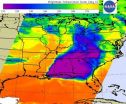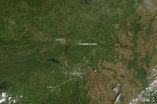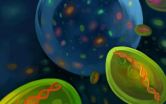(Press-News.org) Researchers at the University of Exeter have found that the probability of a burying beetle winning fights, for the small animal carcasses it needs, depends on a combination of early life experiences and the competition it faces as an adult.
These beetles use small dead animals, such as mice and songbirds, to provide food for their young and competition for a carcass can be fierce.
Previous work has found that success in such contests depends on how good your early adult life environment was, not just how big you are. However, in many animals food availability can vary enormously throughout development, and little is known about how variation in the amount of food animals can find at different times of development affects their success in adulthood.
New work published today in the journal Proceedings of the Royal Society of London - B manipulated the amount of food burying beetles received at two different stages of development: firstly during the larval stage and secondly, when maturing into a young adult (just after emerging from their pupa). Then the adult beetles were put into an arena with a mouse carcass and another beetle of the same sex as a competitor, and the outcome of the contest was recorded.
The size of the beetle in relation to its opponent determined whether the level of competition it faced was low (beetle was larger than opponent) or high (beetle was smaller than opponent).
The amount of food that beetles received when they were larvae affected their size as adults but did not affect their competitive ability against beetles of similar size. In contrast, the amount of food that beetles received as young adults did affect success in contests, especially when the level of competition beetles faced from their opponent was high.
Paul Hopwood, of the Centre for Ecology and Conservation at the University of Exeter, said: "Our research shows that beetles that had a good food supply as developing, young adults were more likely to win contests over carcasses later in life, even if they were smaller than their opponent. In addition, although having a poor food supply as larvae did not affect how competitive beetles were against opponents of similar size, they were smaller, so were more likely to encounter beetles that were larger than themselves. Bigger is most often better in contests, so they were more likely to lose contests than beetles that had good food supply as larvae."
The study provides evidence in support of 'silver spoon' effects, where individuals receiving good nutrition during early development have a lasting advantage over individuals that received poor nutrition during development.
INFORMATION:
This research was funded by the Natural Environment Research Council (NERC).
Bigger is not always better, but it helps, says new research on beetles
2014-04-30
ELSE PRESS RELEASES FROM THIS DATE:
The intergalactic medium unveiled: Caltech's Cosmic Web Imager
2014-04-30
Caltech astronomers have taken unprecedented images of the intergalactic medium (IGM)—the diffuse gas that connects galaxies throughout the universe—with the Cosmic Web Imager, an instrument designed and built at Caltech. Until now, the structure of the IGM has mostly been a matter for theoretical speculation. However, with observations from the Cosmic Web Imager, deployed on the Hale 200-inch telescope at Palomar Observatory, astronomers are obtaining our first three-dimensional pictures of the IGM. The Cosmic Web Imager will make possible a new understanding of galactic ...
Stem cells aid heart regeneration in salamanders
2014-04-29
SAN DIEGO (April 29, 2014) – Imagine filling a hole in your heart by regrowing the tissue. While that possibility is still being explored in people, it is a reality in salamanders. A recent discovery that newt hearts can regenerate may pave the way to new therapies in people who need to have damaged tissue replaced with healthy tissue.
Heart disease is the leading cause of deaths in the United States. Preventative measures like healthful diets and lifestyles help ward off heart problems, but if heart damage does occur, sophisticated treatments and surgical procedures ...
Study confirms increased prevalence of GI symptoms among children with autism
2014-04-29
A new study conducted by researchers at Marcus Autism Center, Children's Healthcare of Atlanta and Emory University School of Medicine indicates that children with autism spectrum disorder (ASD) are more than four times more likely to experience general gastrointestinal (GI) complaints compared with peers, are more than three times as prone to experience constipation and diarrhea than peers, and complain twice as much about abdominal pain compared to peers.
The results were reported in the April 28, 2014, online early edition of the journal Pediatrics.
While parents ...
NASA satellite sees colder temperatures at tops of severe weather thunderstorms
2014-04-29
The weather system that dropped tornadoes in seven central and southern U.S. states on April 27-28, moved east and generated more tornadoes on April 29. NASA's Aqua satellite gathered temperature data on the thunderstorm cloud tops in the system and found them to be higher in the atmosphere and colder. The tornado outbreak over the evening and overnight hours of April 28-29 is thought to have generated more tornadoes in northern Mississippi and Alabama.
NASA's Aqua satellite passed over the eastern U.S. early in the morning on April 29 at 07:41 UTC/3:41 a.m. EDT and gathered ...
Search for extraterrestrial life more difficult than thought
2014-04-29
A new study from the University of Toronto Scarborough suggests the search for life on planets outside our solar system may be more difficult than previously thought.
The study, authored by a team of international researchers led by UTSC Assistant Professor Hanno Rein from the Department of Physical and Environmental Science, finds the method used to detect biosignatures on such planets, known as exoplanets, can produce a false positive result.
The presence of multiple chemicals such as methane and oxygen in an exoplanet's atmosphere is considered an example of a ...
NASA satellite spots tornado track near Conway, Ark.
2014-04-29
A violent tornado touched down in Arkansas on April 27, 2014, killing as many as 15 people. The top image, acquired on April 28 by the Moderate Resolution Imaging Spectroradiometer (MODIS) on NASA's Aqua satellite, shows what appears to be a tornado track north of Little Rock, Arkansas. The lower image, from April 25, shows the same area before the storm. The tracks are pale brown trails where trees and plants have been uprooted, leaving disturbed ground.
The difference in clarity between the two images is likely due to the centering of the scene beneath the satellite. ...
Preliminary results show improvement in MS symptoms
2014-04-29
Combining the estrogen hormone estriol with Copaxone, a drug indicated for the treatment of patients with relapsing forms of multiple sclerosis (MS), may improve symptoms in patients with the disorder, according to preliminary results from a clinical study of 158 patients with relapsing remitting multiple sclerosis (RRMS). The findings were presented today by Rhonda Voskuhl, M.D., from the University of California, Los Angeles, at the American Academy of Neurology Annual Meeting in Philadelphia. The study was funded by the National Institute of Neurological Disorders and ...
Octillions of microbes in the seas: Ocean microbes show incredible genetic diversity
2014-04-29
The smallest, most abundant marine microbe, Prochlorococcus, is a photosynthetic bacterial species essential to the marine ecosystem.
It's estimated that billions of the single-celled creatures live in the oceans, forming the center of the marine food web.
They occupy a range of ecological niches based on temperature, light, water chemistry and interactions with other species.
But the diversity within this single species remains a puzzle.
To probe this question, scientists at the Massachusetts Institute of Technology (MIT) recently performed a cell-by-cell genomic ...
Consuming high-protein breakfasts helps women maintain glucose control, MU study finds
2014-04-29
COLUMBIA, Mo. – In healthy individuals, the amount of glucose, or sugar, in the blood increases after eating. When glucose increases, levels of insulin increase to carry the glucose to the rest of the body. Previous research has shown that extreme increases in glucose and insulin in the blood can lead to poor glucose control and increase an individual's risk of developing diabetes over time. Now, a University of Missouri researcher has found that when women consumed high-protein breakfasts, they maintained better glucose and insulin control than they did with lower-protein ...
New data suggest potassium & dietary fiber intake among toddlers should be priority
2014-04-29
(SAN DIEGO, CA) April 29, 2014 – Recommendations to increase the intake of potassium and dietary fiber among young children should be a priority for the 2020 Dietary Guidelines for Americans, according to a new study by the Alliance for Potato Research and Education (APRE) presented today at Experimental Biology 2014.
While the federal Dietary Guidelines has focused on adults and children 2 years of age and older, the 2020 Dietary Guidelines will include Americans of all ages, starting from birth, noted Maureen Storey, PhD, co-author of the study and APRE president and ...





